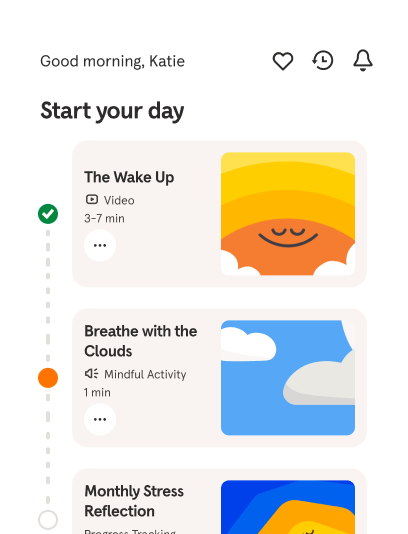Settling Worries
By focusing on worries during one specific time of day, you can let those racing thoughts pass before bedtime.
Try 14 days freeBetter mental health starts with Headspace. Unrivaled expertise to make life feel a little easier, using guided meditations, mindfulness tips, focus tools, sleep support, and dedicated programs.
Try 14 days free
Welcome to the final session of part two. I am so proud of you for coming this far and I hope you're proud of yourself too. I know that taking on some of these new challenges can be scary, but it just so happens that today we're talking about facing your fears. So I'm definitely avoiding going to the dentist out of fear. One of the things that I tend to avoid is finances and managing what my finances look like, so I'm the kind of person that will not check my bank account because I do not want to know how much is in there. When we're experiencing difficult thoughts, feelings, and emotions, it's a natural response to want to pull back and avoid those situations. What can inadvertently happen though when we avoid things that we don't want to feel is then we can also potentially not feel the things that we do want to feel. It would add a lot of value to my life to manage finance as well because I think I would be able to enjoy things more if I know how I can afford them. You can face your fears and other difficult emotions, even if it feels like you can't right now. You just have to start small and make gradual changes. So when you think about how you want to change things for yourselves, it can be helpful to identify what your challenge is, set a plan, and then start taking those steps to move yourself forward. My husband's coming home. Our life as we know it has changed. He's going to have to go into a an assisted situation. What I'd like to focus on that I'm avoiding is really, truly feeling the emotions and the gravity of what's happening right now. As you're picking your personal challenge, it's supposed to feel uncomfortable, but not too hard. I think the unknown is scaring me a lot. Instead of just dealing with it and just having information, you can't walk anymore, and so we have to get like a Hoyer lift and a hospital bed. Something to keep in mind when you are deciding how big of a step to take is that we can oftentimes want to leap farther than we may be able. If we start with something such as running a marathon, we actually may set ourselves further back than we were intending. You know, a small step I could take right away is just going on the internet and seeing if there's places, even support groups. If you are experiencing a strong emotion that's based in trauma or a significant fear, please, please do seek out help from a trusted professional or a friend. Your daily action is you guessed it, to face one of your fears. Choose a small step that you can take this week. Make sure it's something that actually feels uncomfortable for you, because this exercise is all about stepping out of your...
Details
About your teachers
 Andy PuddicomeHeadspace Co-founderMore about Andy
Andy PuddicomeHeadspace Co-founderMore about AndyA former Buddhist monk, Andy has guided people in meditation and mindfulness for 20 years. In his mission to make these practices accessible to all, he co-created the Headspace app in 2010.
 Eve Lewis PrietoHeadspace Director of MeditationMore about Eve
Eve Lewis PrietoHeadspace Director of MeditationMore about EveEve is a mindfulness teacher, overseeing Headspace’s meditation curriculum. She is passionate about sharing meditation to help others feel less stressed and experience more compassion in their lives.
 Dora KamauMeditation TeacherMore about Dora
Dora KamauMeditation TeacherMore about DoraAs a meditation teacher, Dora encourages others to live, breathe, and be with the fullness of their experiences. She loves meditation’s power to create community and bring clarity to people’s minds.
 Kessonga GiscombeMeditation TeacherMore about Kessonga
Kessonga GiscombeMeditation TeacherMore about KessongaKessonga has been an acupuncturists, therapist, and meditation teacher, working to bring mindfulness to the diverse populations of the world.
 Rosie AcostaMeditation TeacherMore about Rosie
Rosie AcostaMeditation TeacherMore about RosieRosie Acosta has studied yoga and mindfulness for more than 20 years and taught for over a decade. Rosie’s mission is to help others overcome adversity and experience radical love.

Your lifelong guide to better mental health
Stress, sleep, and all the challenging emotions — care for your mind with the everyday mental health app that's shown to make a difference.
Try 14 days free
Look after your mind
Proven guided meditations and programs to help you stress less, sleep more soundly, and better navigate life’s challenges

Science-backed
Studies show that using Headspace for 30 days can reduce stress, increase resilience, and improve overall well-being

Explore 1000+ expert-led exercises
Access our library of meditations, breathing exercises, and guidance videos for stress, sleep, focus, everyday anxiety , parenting, and more.




Members are enjoying happier and healthier lives
- © 2026 Headspace Inc.
- Terms & conditions
- Privacy policy
- Consumer Health Data
- Your privacy choices
- CA Privacy Notice


